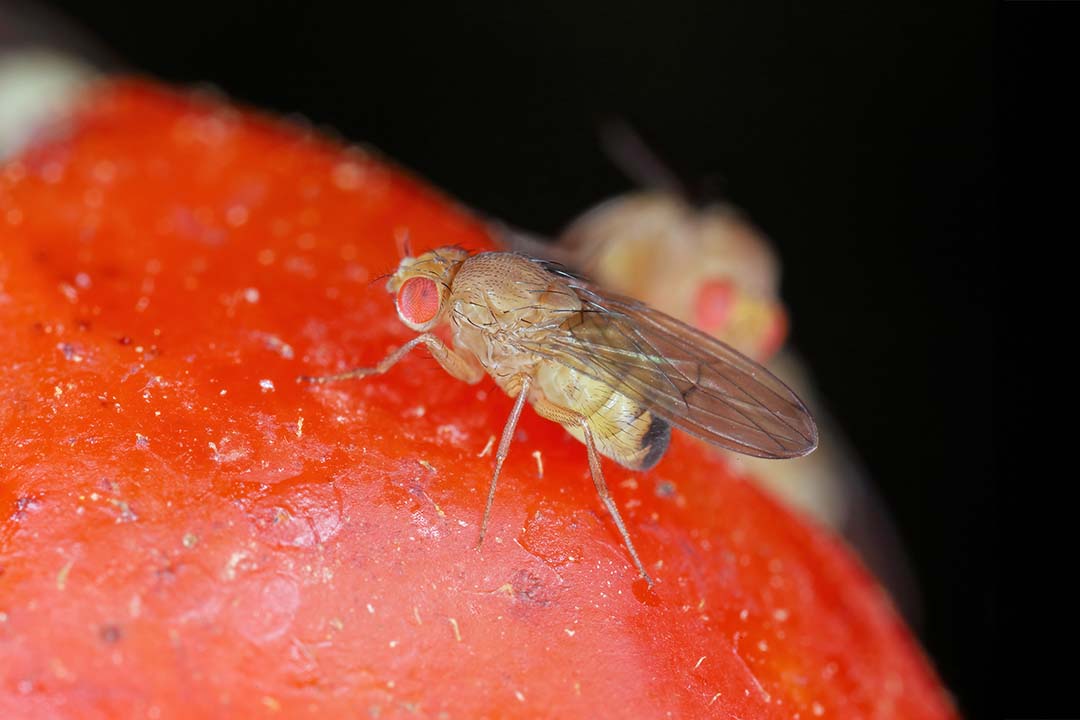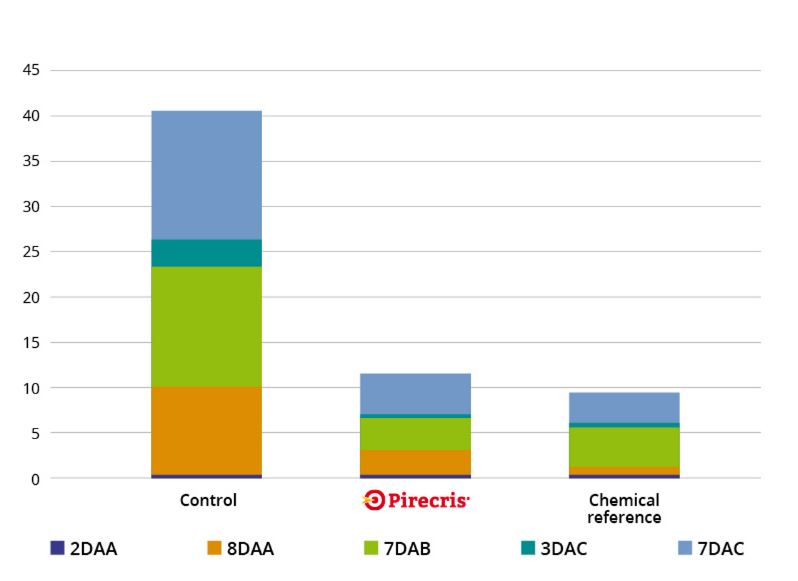Drosophila suzukii in berries: biocontrol strategies

Drosophila suzukii on plant cover.
Drosophila suzukii, or spotted wing drosophila, is a pest with a particular fondness for crops such as berries, cherries and grapes, and with particular characteristics that make it difficult to control. Its history places it first in Japan in 1930s of the last century (hence its original name), although its arrival in Europe is placed in the first decade of the 21st century.
Although adaptable, Drosophila suzukii prefers mild and humid climates: it is active from 10°C and is most active between 20 and 25°C, ceasing activity above 30°C. In the case of berries such as blueberries and raspberries, the risk of attack is even greater as they are usually grown under plastic and in a specific environment of mild temperature and high relative humidity.
The spotted wing drosophila is a small insect, 2 to 3.5 mm in size, yellowish or brownish in colour, with transverse stripes on the abdomen and conspicuous red eyes.
What makes it really dangerous is its tendency to attack ripening fruit. Unlike other fruit flies that feed on rotten, previously damaged, overripe or decaying fruit, Drosophila suzukii attacks healthy, undamaged fruit. This exacerbates the effects of the attack and makes the loss of commercial value of the fruit, and therefore the economic loss of the crop, much more sensitive.
Spotted wing drosophila: damages and life cycle
With the spotted wing drosophila, the physical signs of attack on the flesh are not always visible to the naked eye and sometimes go unnoticed.
Drosophila suzukii lays its eggs in the epidermis of ripe or ripening fruit. If we look closely, we can see tiny bites from which larvae develop, grow inside the fruit and feed on it, causing damage and reducing its commercial value.
The larvae are the most dangerous element because the holes in which they lodge promote secondary infections caused by fungi and diseases that contribute to increased losses.
Control strategies for Drosophila suzukii recommend the use of alternatives that are effective against both adults and larvae. Seipasa’s bioinsecticide Pirecris provides a powerful knockdown effect for the control of spotted wing drosophila or D. suzukii.
The product has also just been extended to include new approved uses on red fruits (strawberry, blueberry, raspberry, blackberry, blackberry), stone and pome fruit trees and persimmon, in addition to the broad range of crops already included in its previous label.
Biocontrol in Drosophila suzukii
Pirecris is a bioinsecticide developed from natural active ingredients that provide a powerful knockdown effect to control insect populations quickly and safely. In addition to its power, Pirecris leaves no residue on the fruit.
The key to the effectiveness of Pirecris lies in its unique patented formulation. Its design ensures a balance between the PI and PII molecules that make up the active substance, providing maximum insecticidal efficacy with a lower dose of active ingredient.
The micro-molecules that make up the formulation condense to form a stable and balanced network throughout the solution, providing perfect coverage on the leaf and insect.
Its powerful knockdown effect blocks sodium and potassium channels in insects, disrupting the transmission of nerve impulses. This causes hyperactivity and abnormal movements, resulting in rapid pest elimination after application.
Pirecris: guaranteed effectiveness
The performance of Pirecris in controlling spotted wing drosophila on strawberry is shown in figure 1, which shows the total number of fruits affected by this pest over the 3 applications in the efficacy trial.
The results show that after the third application there are no significant differences between Pirecris and the chemical reference with which it was compared. Seipasa’s bioinsecticide gives excellent results in stopping the pest’s progress and reducing its incidence on the fruit.
Figure 1: Cumulative number of fruit affected (incidence).
Figure 2 focuses on the number of Drosophila suzukii larvae and the knockdown effect of Pirecris on them. This is a blueberry crop. The product drastically reduces their presence from the first application. It does so with results very similar to those of the chemical reference, with which again no significant differences can be seen.
Figure 2.- Number of Drosophila suzukii larvae in 50 sample fruits per plot.
It should be remembered that the larvae that develop after oviposition are the main destructive agent of the fruit, not only because of their action but also because of the possible entry of infections through the holes created in the fruit. Hence the importance of alternatives such as Pirecris, which act on eggs and larvae, significantly reducing the number of new generations.
Pirecris is also a certified alternative for use in organic farming. Its use allows crop rotation and helps prevent the emergence of resistance.
Biocontrol strategies for Drosophila suzukii in berries must be combined with a series of cultural controls and continuous monitoring of the plots. In addition to the use of insect netting to create physical barriers to the entry of the pest, intensive monitoring of any material or tools that may be infected is recommended as well as careful handling of the crop.
It is advisable to harvest the berries at the right time and not to leave any fruit on the plant after harvest as this could become a food target for new episodes of spotted winged drosophila.



